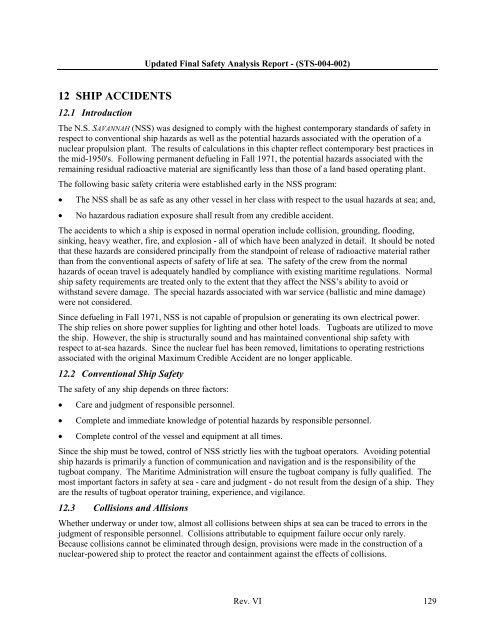10 CFR 50.71(e) - Maritime Administration - U.S. Department of ...
10 CFR 50.71(e) - Maritime Administration - U.S. Department of ...
10 CFR 50.71(e) - Maritime Administration - U.S. Department of ...
Create successful ePaper yourself
Turn your PDF publications into a flip-book with our unique Google optimized e-Paper software.
Updated Final Safety Analysis Report - (STS-004-002)12 SHIP ACCIDENTS12.1 IntroductionThe N.S. SAVANNAH (NSS) was designed to comply with the highest contemporary standards <strong>of</strong> safety inrespect to conventional ship hazards as well as the potential hazards associated with the operation <strong>of</strong> anuclear propulsion plant. The results <strong>of</strong> calculations in this chapter reflect contemporary best practices inthe mid-1950's. Following permanent defueling in Fall 1971, the potential hazards associated with theremaining residual radioactive material are significantly less than those <strong>of</strong> a land based operating plant.The following basic safety criteria were established early in the NSS program:The NSS shall be as safe as any other vessel in her class with respect to the usual hazards at sea; and,No hazardous radiation exposure shall result from any credible accident.The accidents to which a ship is exposed in normal operation include collision, grounding, flooding,sinking, heavy weather, fire, and explosion - all <strong>of</strong> which have been analyzed in detail. It should be notedthat these hazards are considered principally from the standpoint <strong>of</strong> release <strong>of</strong> radioactive material ratherthan from the conventional aspects <strong>of</strong> safety <strong>of</strong> life at sea. The safety <strong>of</strong> the crew from the normalhazards <strong>of</strong> ocean travel is adequately handled by compliance with existing maritime regulations. Normalship safety requirements are treated only to the extent that they affect the NSS’s ability to avoid orwithstand severe damage. The special hazards associated with war service (ballistic and mine damage)were not considered.Since defueling in Fall 1971, NSS is not capable <strong>of</strong> propulsion or generating its own electrical power.The ship relies on shore power supplies for lighting and other hotel loads. Tugboats are utilized to movethe ship. However, the ship is structurally sound and has maintained conventional ship safety withrespect to at-sea hazards. Since the nuclear fuel has been removed, limitations to operating restrictionsassociated with the original Maximum Credible Accident are no longer applicable.12.2 Conventional Ship SafetyThe safety <strong>of</strong> any ship depends on three factors:Care and judgment <strong>of</strong> responsible personnel.Complete and immediate knowledge <strong>of</strong> potential hazards by responsible personnel.Complete control <strong>of</strong> the vessel and equipment at all times.Since the ship must be towed, control <strong>of</strong> NSS strictly lies with the tugboat operators. Avoiding potentialship hazards is primarily a function <strong>of</strong> communication and navigation and is the responsibility <strong>of</strong> thetugboat company. The <strong>Maritime</strong> <strong>Administration</strong> will ensure the tugboat company is fully qualified. Themost important factors in safety at sea - care and judgment - do not result from the design <strong>of</strong> a ship. Theyare the results <strong>of</strong> tugboat operator training, experience, and vigilance.12.3 Collisions and AllisionsWhether underway or under tow, almost all collisions between ships at sea can be traced to errors in thejudgment <strong>of</strong> responsible personnel. Collisions attributable to equipment failure occur only rarely.Because collisions cannot be eliminated through design, provisions were made in the construction <strong>of</strong> anuclear-powered ship to protect the reactor and containment against the effects <strong>of</strong> collisions.Rev. VI 129
















